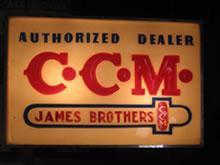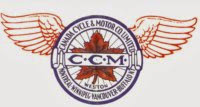Recent comments
-
Reply to: CCM Bottom Bracket
While it could be an Ashtabula style, single piece crankset, if it actually is an old CCM double bar (i.e. Motorbike) frame, there is a higher probability that it is a CCM Triplex crankset. You also can't rule out the possibility of a three piece, cottered crankset, as these were used on some of CCM's budget brands. Please post a picture for positive identification of the crankset.
-
Reply to: Cable barrel for stick shift
shimano shifter and sturmney hub will not work perfectly together hope this helps william rudolph
-
Reply to: CCM Bottom Bracket
try you tube asbula or one piece crank repair hope this helps william rudolph ps a picture would help to determin what crank you have
-
Reply to: 60's Rambler?
Very informative! Thank you.
-
Reply to: 60's Rambler?
Both the one piece and three piece styles of head tubes assemblies existed concurrently for over a century. Consequently, the use of one style over the other is not timeline related. Rather, it's a cost based decision, with the three piece style typically being used on more expensive bicycles and the one piece style being employed on lower priced bicycles.
In the three piece style, the fittings used to connect the frame tubes to the head tube are referred to as "lugs". The traditional way to manufacture both the one piece head tube assembly and lugs was the same. You stamp out the shape, then form it and weld it. There's not much difference in the material costs between the two methods but there is a big difference in labour costs since it takes almost twice as long to manufacture two lugs. Then when you go to assemble the frame there's twice as much brazing and clean-up due to the separate head tube, which are costly, labour intensive processes. Around the early 1960s, bulge forming was adopted to manufacture the one piece style, which made it even less expensive.
Also, since lugs were used on more expensive models, manufacturers started to dress up the lugs to justify the extra cost to the consumer. The designs can be quite elaborate with extensive edge sculpting, cut-outs, chrome plating, contrasting colours, and/or pinstriped outlines. The one piece style can also be dressed-up but due to their target price level, its typically quite mild. Consequently, by comparison, the one piece style looks rather plain and to the average consumer the lugged head tubes look more expensive. This subconsciously justifies the extras cost and leads to the impression that it is the superior style. In fact, they do have some marginal advantages but besides the aesthetics, they're inconsequential to the typical consumer.
Both styles gradually died out during the last two decades of the 20th century, though the lugged style is still produced by some custom, high end frame builders. Currently, all levels of the market for metal frames are dominated by welded frames, wherein the frame tubes are directly joined to the head tube.
If you looked at CCM's model lines for both the Rambler 500 era (1966-1967) and the Seville era (1978-1980) you'll find both styles and that they indicate the relative positions of these models in the product lines for their eras.




